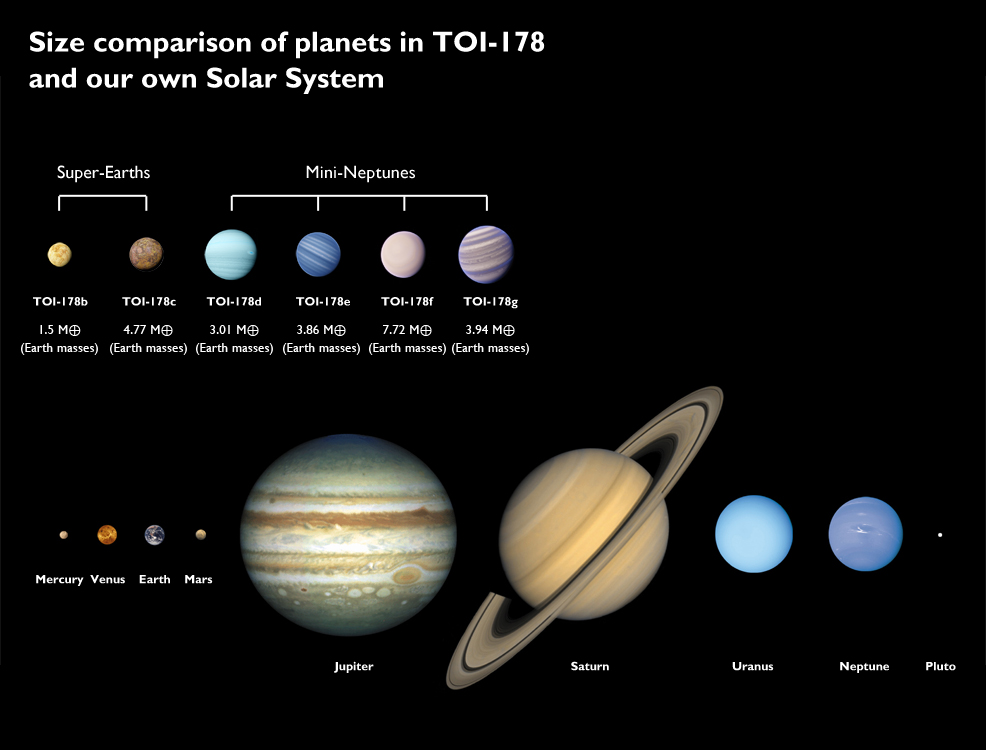
30th January 2021 Rare system of six exoplanets discovered Astronomers report the discovery of TOI-178, a rare system of six exoplanets, five of which are locked in a complex "chain of resonance".
Using a combination of telescopes – including the Very Large Telescope (VLT) of the European Southern Observatory (ESO), astronomers have revealed a system consisting of six exoplanets, five of which are locked in a rare rhythm around their central star. The researchers believe this could provide important clues about how planets, including those in our Solar System, form and evolve. TOI-178 is a K-class (orange dwarf) star located 205 light years away in the constellation of Sculptor. The first time astronomers observed it, they thought they had spotted two planets going around in the same orbit. However, a closer look revealed something entirely different. "Through further observations we realised that there were not two planets orbiting the star at roughly the same distance from it, but rather multiple planets in a very special configuration," explains Adrien Leleu from the Université de Genève and the University of Bern, Switzerland, who led a new study of the system scheduled for publication in Astronomy & Astrophysics. The new research finds that the system boasts six exoplanets and that all but the one closest to the star are locked in a rhythmic dance as they move around in their orbits. In other words, they are in "resonance". This means there are patterns that repeat themselves as the planets go around the star, with some planets aligning every few orbits. A similar resonance occurs in the orbits of Io, Europa and Ganymede, three of Jupiter's moons. Io, the closest of the three to Jupiter, completes four full orbits around Jupiter for every orbit that Ganymede, the furthest away, makes, and two full orbits for every orbit Europa makes. The five outer planets of TOI-178 follow a much more complex chain of resonance, one of the longest yet discovered in a system of exoplanets. While the three Jupiter moons are in a 4:2:1 resonance, the five outer planets in the TOI-178 system follow an 18:9:6:4:3 chain: while the second planet from the star (the first in the resonance chain) completes 18 orbits, the third planet from the star (second in the chain) completes nine orbits, and so on. In fact, the scientists initially only found five planets in the system, but by following this resonant rhythm they calculated where in its orbit an additional planet would be when they next had a window to observe the system.
More than just an orbital curiosity, this dance of resonant planets can provide clues about the system's past. "The orbits in this system are very well ordered, which tells us that this system has evolved quite gently since its birth," explains co-author Yann Alibert from the University of Bern. If the system had been significantly disturbed earlier in its life – by a giant impact, for example – this fragile configuration of orbits would not have survived. To investigate the system's unusual configuration, the team used data from the European Space Agency's CHEOPS spacecraft, alongside the ground-based ESPRESSO instrument on ESO's VLT, as well as the NGTS and SPECULOOS, both sited at the Paranal Observatory in Chile. Since exoplanets are extremely tricky to spot directly with telescopes, astronomers must instead rely on other techniques to detect them. The main methods used are imaging transits – observing the light emitted by the central star, which dims as an exoplanet passes in front of it when observed from the Earth – and radial velocities – observing the star's light spectrum for small signs of wobbles which happen as the exoplanets move in their orbits. The team used both methods to observe the system: CHEOPS, NGTS and SPECULOOS for transits, and ESPRESSO for radial velocities. By combining the two techniques, the astronomers gained key information about the system and its planets, which orbit their central star much closer and faster than the Earth orbits the Sun. The fastest (and innermost) planet completes an orbit in two days, while the slowest takes 21 days. For comparison, Mercury goes around our Sun in 88 days. The six planets have sizes ranging from about one to about three times the size of Earth, while their masses are 1.5 to 7.7 times the Earth's mass. Two of the planets are rocky, but larger than Earth – these are known as Super-Earths. The other four are gas planets, like the outer planets in our own Solar System, but somewhat smaller – these are nicknamed Mini-Neptunes. Although none of the six exoplanets lies in the star's habitable zone, the researchers suggest that, by continuing the resonance chain, they might find additional planets that could exist in or very close to this zone. ESO's Extremely Large Telescope (ELT), which is scheduled to begin operating in 2025, will be capable of directly imaging rocky exoplanets in a star's habitable zone and will even characterise their atmospheres, presenting an opportunity to get to know systems like TOI-178 in even greater detail.
Comments »
If you enjoyed this article, please consider sharing it:
|







